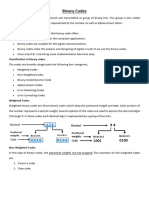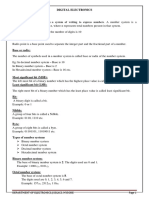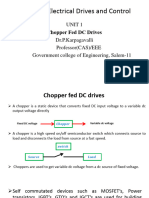Number Systems and Codes
Number Systems
Decimal number: 123.45 = 1 102 + 2 101 + 3 100 + 4 10-1 + 5 10-2
Base b number: N = aq-1bq-1 + + a0b0 + + a-pb-p
b >1, 0 <= ai <= b-1
Integer part: aq-1aq-2 a0
Fractional part: a-1a-2 a-p
Most significant digit: aq-1
Least significant digit: a-p
Binary number (b=2): 1101.01 = 1 23 + 1 22 + 0 21 + 1 20 + 0 2-1 + 1 2-2
Representing number N in base b: (N)b
Complement of digit a: a’ = (b-1)-a
Decimal system: 9’s complement of 3 = 9-3 = 6
Binary system: 1’s complement of 1 = 1-1 = 0 2
1
�Representation of Integers
Conversion of Bases
Example: Base 8 to base 10
(432.2)8 = 4 82 + 3 81 + 2 80 + 2 8-1 = (282.25)10
Example: Base 2 to base 10
(1101.01)2 = 1 23 + 1 22 + 0 21 + 1 20 + 0 2-1 + 1 2-2 = (13.25)10
Base b1 to b2, where b1 > b2:
2
�Conversion of Bases (Contd.)
Example: Convert (548)10 to base 8
Thus, (548)10 = (1044)8
Example: Convert (345)10 to base 6
5
Thus, (345)10 = (1333)6
Converting Fractional Numbers
Fractional number:
Example: Convert (0.3125)10 to base 8
0.3125 8 = 2.5000 hence a-1 = 2
0.5000 8 = 4.0000 hence a-2 = 4
Thus, (0.3125)10 = (0.24)8
3
�Decimal to Binary
Example: Convert (432.354)10 to binary
0.354 2 = 0.708 hence a-1 = 0
0.708 2 = 1.416 hence a-2 = 1
0.416 2 = 0.832 hence a-3 = 0
0.832 2 = 1.664 hence a-4 = 1
0.664 2 = 1.328 hence a-5 = 1
0.328 2 = 0.656 hence a-6 = 0
a-7 = 1
etc.
Thus, (432.354)10 = (110110000.0101101…)2
Octal/Binary Conversion
Example: Convert (123.4)8 to binary
(123.4)8 = (001 010 011.100)2
Example: Convert (1010110.0101)2 to octal
(1010110.0101)2 = (001 010 110.010 100)2 = (126.24)8
4
�Binary Arithmetic
Binary Addition/Subtraction
Example: Binary addition
1111 = carries of 1
1111.01 = (15.25)10
0111.10 = ( 7.50)10
10110.11 = (22.75)10
Example: Binary subtraction
1 = borrows of 1
10010.11 = (18.75)10
01100.10 = (12.50)10
00110.01 = ( 6.25)10
10
5
�Binary Multiplication/Division
Example: Binary multiplication
11001.1 = (25.5)10
110.1 = ( 6.5)10
110011
000000
110011
110011
10100101.11 = (165.75)10
Example: Binary division
10110 = quotient
11001 1000100110
11001
00100101
11001
0011001
11001
11
00000 = remainder
Binary Codes
BCD Self-complementing Codes
Self-complementing code: Code word of 9’s complement of N obtained
by interchanging 1’s and 0’s in the code word of N
12
6
�Nonweighted Codes
Add 3 to Successive code words
BCD differ in only one digit
13
Gray Code
14
7
�Binary Gray
Example:
Binary:
Gray:
Gray-to-binary:
• bi = gi if no. of 1’s preceding gi is even
• bi = gi’ if no. of 1’s preceding gi is odd
15
Reflection of Gray Codes
00 0 00 0 000
01 0 01 0 001
11 0 11 0 011
10 0 10 0 010
1 10 0 110
1 11 0 111
1 01 0 101
1 00 0 100
1 100
1 101
1 111
1 110
1 010
1 011
1 001
1 000
16
8
�Error-detecting Codes
p: parity bit; even parity used in above codes
Distance between codewords: no. of bits they differ in
Minimum distance of a code: smallest no. of bits in which any two
code words differ 17
Minimum distance of above single error-detecting codes = 2
Hamming Codes: Single Error-correcting
Minimum distance for SEC or double-error detecting (DED) codes = 3
Example: {000,111}
Minimum distance for SEC and DED codes = 4
No. of information bits = m
No. of parity check bits, p1, p2, …, pk = k
No. of bits in the code word = m+k
Assign a decimal value to each of the m+k bits: from 1 to MSB to m+k to
LSB
Perform k parity checks on selected bits of each code word: record results
as 0 or 1
• Form a binary number (called position number), c1c2…ck, with the k
parity checks 18
9
�Hamming Codes (Contd.)
No. of parity check bits, k, must satisfy: 2k >= m+k+1
Example: if m = 4 then k =3
Place check bits at the following locations: 1, 2, 4, …, 2k-1
Example code word: 1100110
• Check bits: p1= 1, p2 = 1, p3 = 0
• Information bits: 0, 1, 1, 0
19
Hamming Code Construction
Select p1 to establish even parity in positions: 1, 3, 5, 7
Select p2 to establish even parity in positions: 2, 3, 6, 7
Select p3 to establish even parity in positions: 4, 5, 6, 7
20
10
�Hamming Code Construction (Contd.)
Position: 1 2 3 4 5 6 7
p1 p2 m1 p3 m2 m3 m4
Original BCD message: 0 1 0 0
Parity check in positions 1,3,5,7 requires p1=1: 1 0 1 0 0
Parity check in positions 2,3,6,7 requires p2=0: 1 0 0 1 0 0
Parity check in positions 4,5,6,7 requires p3=1: 1 0 0 1 1 0 0
Coded message: 1 0 0 1 1 0 0
21
Hamming Code for BCD
Position: 1 2 3 4 5 6 7
Intended message: 1 1 0 1 0 0 1
Message received: 1 1 0 1 1 0 1
4-5-6-7 parity check: 1 1 0 1 c1 = 1 since parity is odd
2-3-6-7 parity check: 1 0 0 1 c2 = 0 since parity is even
22
1-3-5-7 parity check: 1 0 1 1 c3 = 1 since parity is odd
11
�SEC/DED Code
Add another parity bit such that all eight bits have even parity
• Two errors occur: overall parity check satisfied, but position number
indicates error double error (cannot be corrected)
• Single error occurs: overall parity check not satisfied
• Position no. is 0: error in last parity bit
• Else, position no. indicates erroneous bit
• No error occurs: all parity checks indicate even parities
23
12





























































